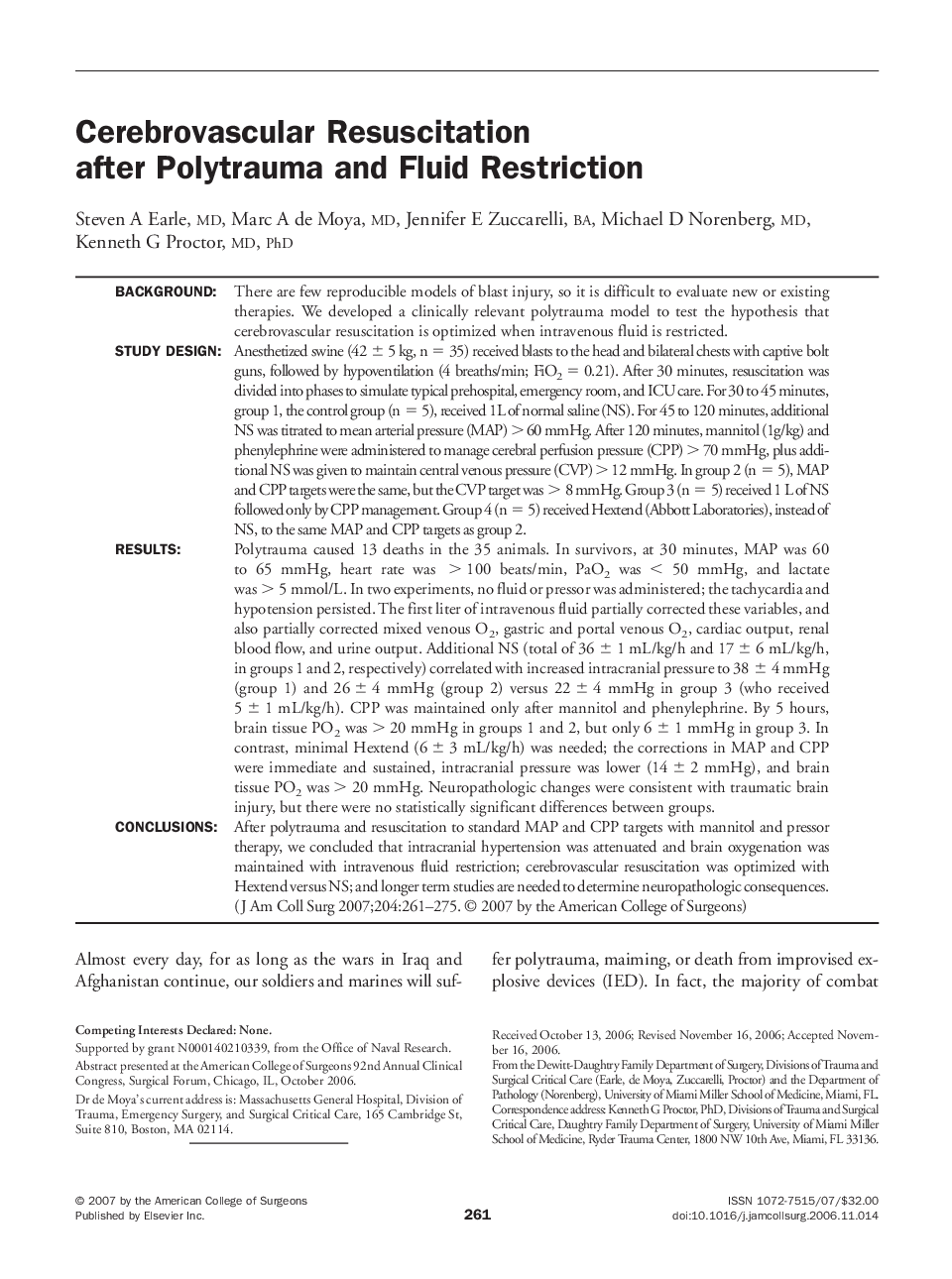| کد مقاله | کد نشریه | سال انتشار | مقاله انگلیسی | نسخه تمام متن |
|---|---|---|---|---|
| 4295439 | 1612329 | 2007 | 15 صفحه PDF | دانلود رایگان |

BackgroundThere are few reproducible models of blast injury, so it is difficult to evaluate new or existing therapies. We developed a clinically relevant polytrauma model to test the hypothesis that cerebrovascular resuscitation is optimized when intravenous fluid is restricted.Study designAnesthetized swine (42 ± 5 kg, n = 35) received blasts to the head and bilateral chests with captive bolt guns, followed by hypoventilation (4 breaths/min; FiO2 = 0.21). After 30 minutes, resuscitation was divided into phases to simulate typical prehospital, emergency room, and ICU care. For 30 to 45 minutes, group 1, the control group (n = 5), received 1L of normal saline (NS). For 45 to 120 minutes, additional NS was titrated to mean arterial pressure (MAP) > 60 mmHg. After 120 minutes, mannitol (1g/kg) and phenylephrine were administered to manage cerebral perfusion pressure (CPP) > 70 mmHg, plus additional NS was given to maintain central venous pressure (CVP) > 12 mmHg. In group 2 (n = 5), MAP and CPP targets were the same, but the CVP target was > 8 mmHg. Group 3 (n = 5) received 1 L of NS followed only by CPP management. Group 4 (n = 5) received Hextend (Abbott Laboratories), instead of NS, to the same MAP and CPP targets as group 2.ResultsPolytrauma caused 13 deaths in the 35 animals. In survivors, at 30 minutes, MAP was 60 to 65 mmHg, heart rate was > 100 beats/min, PaO2 was < 50 mmHg, and lactate was > 5 mmol/L. In two experiments, no fluid or pressor was administered; the tachycardia and hypotension persisted. The first liter of intravenous fluid partially corrected these variables, and also partially corrected mixed venous O2, gastric and portal venous O2, cardiac output, renal blood flow, and urine output. Additional NS (total of 36 ± 1 mL/kg/h and 17 ± 6 mL/kg/h, in groups 1 and 2, respectively) correlated with increased intracranial pressure to 38 ± 4 mmHg (group 1) and 26 ± 4 mmHg (group 2) versus 22 ± 4 mmHg in group 3 (who received 5 ± 1 mL/kg/h). CPP was maintained only after mannitol and phenylephrine. By 5 hours, brain tissue PO2 was > 20 mmHg in groups 1 and 2, but only 6 ± 1 mmHg in group 3. In contrast, minimal Hextend (6 ± 3 mL/kg/h) was needed; the corrections in MAP and CPP were immediate and sustained, intracranial pressure was lower (14 ± 2 mmHg), and brain tissue PO2 was > 20 mmHg. Neuropathologic changes were consistent with traumatic brain injury, but there were no statistically significant differences between groups.ConclusionsAfter polytrauma and resuscitation to standard MAP and CPP targets with mannitol and pressor therapy, we concluded that intracranial hypertension was attenuated and brain oxygenation was maintained with intravenous fluid restriction; cerebrovascular resuscitation was optimized with Hextend versus NS; and longer term studies are needed to determine neuropathologic consequences.
Journal: Journal of the American College of Surgeons - Volume 204, Issue 2, February 2007, Pages 261–275